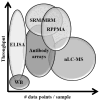Analytical challenges translating mass spectrometry-based phosphoproteomics from discovery to clinical applications
- PMID: 24890697
- PMCID: PMC4250476
- DOI: 10.1002/elps.201400153
Analytical challenges translating mass spectrometry-based phosphoproteomics from discovery to clinical applications
Abstract
Phosphoproteomics is the systematic study of one of the most common protein modifications in high throughput with the aim of providing detailed information of the control, response, and communication of biological systems in health and disease. Advances in analytical technologies and strategies, in particular the contributions of high-resolution mass spectrometers, efficient enrichments of phosphopeptides, and fast data acquisition and annotation, have catalyzed dramatic expansion of signaling landscapes in multiple systems during the past decade. While phosphoproteomics is an essential inquiry to map high-resolution signaling networks and to find relevant events among the apparently ubiquitous and widespread modifications of proteome, it presents tremendous challenges in separation sciences to translate it from discovery to clinical practice. In this mini-review, we summarize the analytical tools currently utilized for phosphoproteomic analysis (with focus on MS), progresses made on deciphering clinically relevant kinase-substrate networks, MS uses for biomarker discovery and validation, and the potential of phosphoproteomics for disease diagnostics and personalized medicine.
Keywords: Kinase; MS; Phosphoproteomics.
© 2014 WILEY-VCH Verlag GmbH & Co. KGaA, Weinheim.
Conflict of interest statement
The authors have declared no conflict of interest.
Figures




References
Publication types
MeSH terms
Substances
Grants and funding
LinkOut - more resources
Full Text Sources
Other Literature Sources
Miscellaneous

